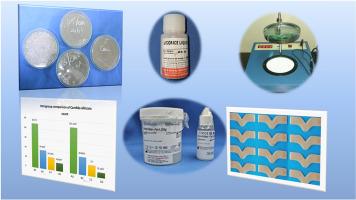甘草颌面硅胶抗撕裂强度、抗真菌效果及多微生物耐药性的体外评价
Q1 Medicine
Journal of oral biology and craniofacial research
Pub Date : 2025-07-22
DOI:10.1016/j.jobcr.2025.07.010
引用次数: 0
摘要
目的研究不同浓度光甘草(0%、1.5%、2.5%和5%)修饰的颌面部硅胶的撕裂强度、抗念珠菌作用和对多微生物生物膜形成的抗性,重点研究其耐久性、抗菌性能和综合性能。方法共制备192份样品,按甘草浓度进行分组,按各参数再设亚组,每浓度组48份。撕裂强度采用万能试验机测试,以N/mm表示。通过接种白色念珠菌和白色念珠菌与金黄色葡萄球菌混合培养,在24 h和48 h测定菌落计数,评估样品的抗念珠菌和多微生物生物膜性能。结果增加光甘草浓度可显著提高撕裂强度和抗菌性能。撕裂强度逐渐提高,D组(5%浓度)撕裂强度最高,为12.43 N/mm。抗念珠菌效果表现出明显的剂量依赖性,D组使白色念珠菌计数从a组的225.75减少到24 h时的40.67,48 h时进一步减少到25.17。多微生物生物膜的形成也明显减少,其中D组的最低计数为24 h时的163.33 CFU和48 h时的163.08 CFU。Tukey事后检验显示各组间差异显著(P <;0.001)和对照,强调浓度越高,效果越好。结论颌面部硅胶中加入光甘草可显著提高其撕裂强度、抗念珠菌和抗多微生物性能。本文章由计算机程序翻译,如有差异,请以英文原文为准。

In vitro evaluation of tear strength, antifungal effect, and polymicrobial resistance in Glycyrrhiza glabra–incorporated maxillofacial silicone
Objectives
This study aimed to evaluate the tear strength, anti-candidal effect, and resistance to polymicrobial biofilm formation of maxillofacial silicone modified with varying concentrations of Glycyrrhiza glabra (0 %, 1.5 %, 2.5 %, and 5 %), focusing on enhancing its durability, antimicrobial properties, and overall performance.
Methods
A total of 192 samples were prepared and divided into groups based on Glycyrrhiza glabra concentrations, with further subgroups for each parameter with 48 samples in each concentration group. Tear strength was tested using a universal testing machine and expressed in N/mm. Anti-candidal and polymicrobial biofilm properties were assessed by inoculating samples with Candida albicans and a mixed culture of Candida albicans and Staphylococcus aureus, with colony counts measured at 24 and 48 h.
Results
Increasing the concentration of Glycyrrhiza glabra significantly enhanced tear strength and antimicrobial properties. Tear strength improved progressively, with Group D (5 % concentration) achieving the highest value of 12.43 N/mm. Anti-candidal efficacy showed a clear dose-dependent effect, with Group D reducing Candida albicans counts from 225.75 in Group A to 40.67 at 24 h and further to 25.17 at 48 h. Polymicrobial biofilm formation also decreased significantly, with Group D showing the lowest counts of 163.33 CFU at 24 h and 163.08 CFU at 48 h. Tukey's post hoc test revealed significant differences between treatment groups (P < 0.001) and controls, highlighting that higher concentrations offered superior performance.
Conclusion
The incorporation of Glycyrrhiza glabra into maxillofacial silicone significantly enhances tear strength, anti-candidal, and anti-polymicrobial properties.
求助全文
通过发布文献求助,成功后即可免费获取论文全文。
去求助
来源期刊

Journal of oral biology and craniofacial research
Medicine-Otorhinolaryngology
CiteScore
4.90
自引率
0.00%
发文量
133
审稿时长
167 days
期刊介绍:
Journal of Oral Biology and Craniofacial Research (JOBCR)is the official journal of the Craniofacial Research Foundation (CRF). The journal aims to provide a common platform for both clinical and translational research and to promote interdisciplinary sciences in craniofacial region. JOBCR publishes content that includes diseases, injuries and defects in the head, neck, face, jaws and the hard and soft tissues of the mouth and jaws and face region; diagnosis and medical management of diseases specific to the orofacial tissues and of oral manifestations of systemic diseases; studies on identifying populations at risk of oral disease or in need of specific care, and comparing regional, environmental, social, and access similarities and differences in dental care between populations; diseases of the mouth and related structures like salivary glands, temporomandibular joints, facial muscles and perioral skin; biomedical engineering, tissue engineering and stem cells. The journal publishes reviews, commentaries, peer-reviewed original research articles, short communication, and case reports.
 求助内容:
求助内容: 应助结果提醒方式:
应助结果提醒方式:


